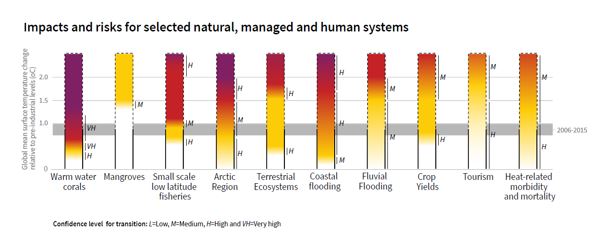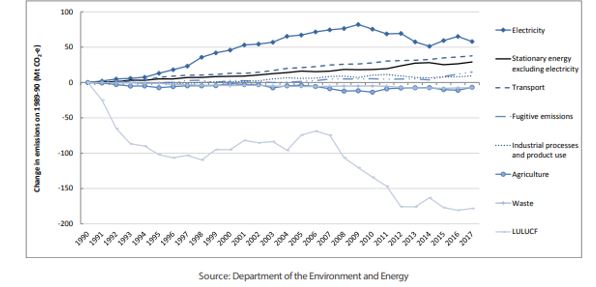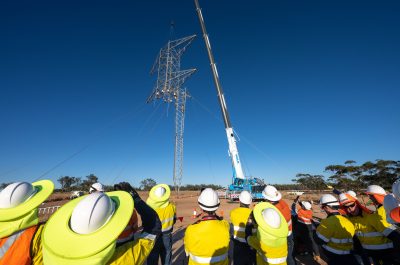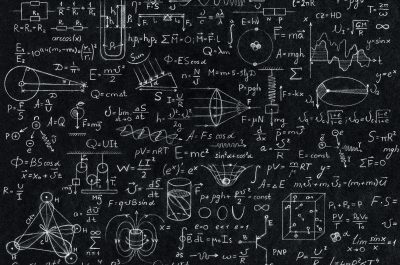Half a degree too far?
Next month, all 25 participating countries of the Paris Agreement will meet in Poland to talk about how they’re tracking on their commitments. Ahead of this summit, the Intergovernmental Panel on Climate Change (IPCC)[1] was asked to prepare an assessment of limiting warming to 1.5°C, its impacts and related pathways. The report was finalised in South Korea last week and released last Monday, October 8
The main message is that global warming is currently at 1.0°C above pre-industrial levels and is likely[2] to reach 1.5°C between 2030 and 2052 if it continues to increase at the current rate. The report says that under the commitments made by parties to the agreement, global warming will reach 3.0°C by the end of the century.
Global Warming of 1.5°C – A massive task!
In general, climate risks are lower at warming levels of 1.5°C compared with 2.0°C, while the mitigation effort required for the 1.5°C scenario are much higher. The figure below demonstrates that CO2 emissions will need to decline to net zero by 2040 (compared to 2055 in the 2°C scenario). As shown, it has taken almost 40 years to double the global CO2 emissions but the path forward to limit warming to 1.5°C would require global CO2 emissions to be reduced to zero in the coming 20 years, half the time and double the emissions compared with the historical growth.
Stylized net global CO2 emission pathways

The report makes the following comparisons[3] between the 1.5°C and 2.0°C scenarios.
- Temperature extremes on land increase by about 3°C at global warming of 1.5°C and about 4°C at 2°C. Extreme cold nights warm by 4.5°C and 6.0°C respectively.
- The number of hot days is projected to increase in most land regions, with highest increases in the tropics.
- Impacts associated with forest fires, or spread of invasive species are lower at 1.5°C.
- Risks from diseases such as malaria and dengue fever are projected to increase with warming from 1.5 to 2.0°C, with potential shifts in their geographic range.
- Limiting global warming to 1.5°C compared to 2.0°C may reduce the proportion of the world’s population due to an increase in water stress by up to 50 per cent.
The figure below provides a summary of all the impacts on these natural, managed and human systems as the world heats up to 1.5°C, impacts which increase if global warming reaches 2.0°C.

So, the report warns, more warming equals increased extreme weather events, decreased biodiversity and greater adverse impacts on human health.
The report does illustrate how warming can be limited to 1.5°C. The pathway for 2.0°C required global emissions to decline by 20 per cent by 2030 and to reach net zero by 2075. In the 1.5°C scenario this accelerates to 45 per cent reduction by 2030 and reaching net zero around 2050. This can potentially be achieved through lower energy use, increased energy efficiency and faster electrification of energy end-use compared with the 2.0°C scenario. Reaching emissions reductions by 2050 could be achieved through a combination of new and existing technologies and practices, including electrification, hydrogen, sustainable bio-based feed stocks, product substitutions, and carbon capture, utilisation and storage (CCUS).
Cost factor?
While the technologies are available and the models indicate that global warming can be limited to 1.5°C, what will this all cost? The report indicates that an average annual investment in the energy system of about US$2.4 trillion will be required between 2016 and 2035, representing about 2.5 per cent of the world Gross Domestic Product. There are also costs associated with not taking action, however, these are generally difficult to quantify. Additionally, traditional energy investments are inherently long-term investments, so changing the metric from 2.0°C to 1.5°C increases the commercial risks to those investments. So justifying significant capital expenditure against loosely quantifiable (and futuristic) potential impacts remains a challenge.
While the report by itself cannot reduce emissions, it is hoped that its content may encourage countries to step up their efforts at the upcoming meeting in Poland. But it is not clear how, and if, that can be achieved when the US has actively retreated from the Paris Agreement.
So how are we tracking?
Australia’s agreed contribution in the Paris agreement was to reduce annual emissions by between 26 to 28 percent by 2030 from 2005 levels. The latest government report shows that our annual emissions increased by 1.3 per cent in the last year.

Australia is still a long way from reaching its 2030 goal and there are no immediate policies on the horizon to facilitate it. Noting the current international contributions are insufficient to meet a 2.0°C target[4] and that additional efforts will be required for a 1.5°C target, there is a clear role for supportive policies to close those gaps.
Innovation driving emission reductions
Networks are continuing to make progress to support reductions of emissions. Some activities include:
- Planning better ways to integrate distributed energy resources into the grid.
- Supporting stand-alone power systems.
- Testing the role of battery technology into the network.
- Supporting the roll out of electric vehicles, whether they be battery or fuel celled electric vehicles; and
- Developing opportunities to decarbonise gas supplied in networks through the introduction of biogas and/or hydrogen.
Deploying these technologies will result in major emission reductions from electricity and gas use, and will also lead to major reductions from the transport sector, as proposed in the IPCC report. The right policy settings will help industry accelerate progress, but additional activity will also be required outside of the energy sector to reach the national and international carbon reduction goals. This activity will need to increase substantially if the limit for global warming is set at 1.5°C.
[1] The International Panel on Climate Change – the lead body of international scientists on climate change.
[2] The IPCC makes statements in terms of level of confidence using five qualifiers. Very high, high, medium, low and very low.
[3] The Report makes lots of comparisons. I have only included a few here that were all listed as high or very high confidence.
[4] Current global commitments to reduce emissions will see global warming of 3.0°C or above.


